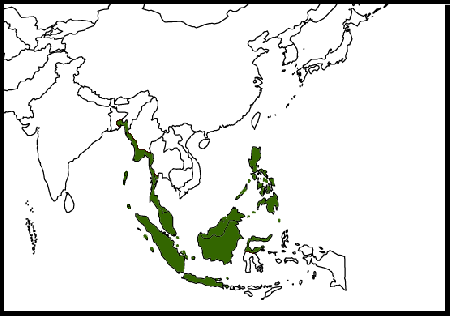Alternative names: Philippine Glossy Starling; Indonesian Tree Starling; Bornean Starling
- Aplonis panayensis
Identification
20cm (7¾ in). A medium-sized starling with bristly forehead feathers and lanceolate throat feathers.
- Black plumage with greenish to oily gloss (lowermost underparts are matt black)
- Small black mask on lores and around eye
- Red eye
- Black bill and legs
Sexes similar.
Juveniles have bold dark streaks over a greyish-brown dull white body.
Variations
The subspecies differ in bill size and colour of gloss.
Distribution
| Found from northeast India to Bangladesh along the coast of Burma to south Thailand, Malaysia, Sumatra, Borneo, Java, Bali, parts of Sulawesi, the Philippines. Common and widespread. | |
| Legend • A. panayensis; year-round |
Taxonomy
Subspecies
There are 14 subspecies[1]:
- A. p. affinis:
- Assam to Bangladesh and Myanmar (Arakan Yoma Mountains)
- A. p. strigata:
- A. p. tytleri:
- Andaman Islands and Car Nicobar Islands
- A. p. albiris:
- Great and Central Nicobar Islands
- A. p. heterochlora:
- Anambas and Natuna islands (off Borneo)
- A. p. eustathis:
- Eastern Borneo
- A. p. alipodis:
- Panjang, Maratau and Derawan islands (off eastern Borneo)
- A. p. panayensis:
- Northern Sulawesi and Philippine Islands
- A. p. sanghirensis:
- Talaud, Sangihe, Siau, Tahjlandang, Ruang, and Biaro islands
- A. p. enganensis:
- Enggano Island (off southern Sumatra)
- A. p. altirostris:
- Simuelue, Banyan and Nias islands (off western Sumatra)
- A. p. leptorrhyncha:
- Batu Island (off western Sumatra)
- A. p. pachistorhina:
- Mentawi Islands (off western Sumatra)
- A. p. gusti:
leptorrhyncha is not accepted by all authorities[2]
Habitat
Moist lowland forests, mangrove forests, open country, farms, plantations and gardens. Occurs generally below 700m.
Behaviour
Diet
The diet includes mainly soft fruits (papaya, banana, mango, figs) but may also take nectar, insects, spiders and snails.
Highly gregarious, feeds mainly in flocks.
Breeding
They nest in tree holes, palm tree crowns and thickets of epiphytic ferns. When a hole is used, little nesting material is used; otherwise, the nest is built using grass and items of rubbish, such as paper. Three eggs (blue, spotted dark brown) are laid at any time of the year, peaking March-June.
Movements
Mostly a resident species with some local movements.
References
- Clements, J. F., T. S. Schulenberg, M. J. Iliff, D. Roberson, T. A. Fredericks, B. L. Sullivan, and C. L. Wood. 2016. The eBird/Clements checklist of birds of the world: v2016, with updates to August 2016. Downloaded from http://www.birds.cornell.edu/clementschecklist/download/
- Del Hoyo, J, A Elliott, and D Christie, eds. 2009. Handbook of the Birds of the World. Volume 14: Bush-shrikes to Old World Sparrows. Barcelona: Lynx Edicions. ISBN 978-8496553507
- Avibase
- BF Member observations
Recommended Citation
- BirdForum Opus contributors. (2025) Asian Glossy Starling. In: BirdForum, the forum for wild birds and birding. Retrieved 17 May 2025 from https://www.birdforum.net/opus/Asian_Glossy_Starling
External Links
GSearch checked for 2020 platform.1







